Ziwei Chen
Kimi-VL Technical Report
Apr 10, 2025

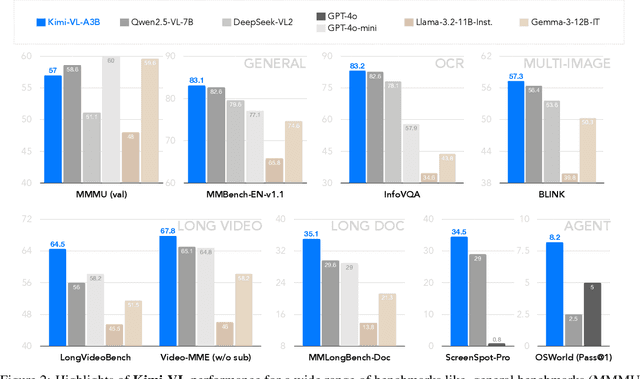

Abstract:We present Kimi-VL, an efficient open-source Mixture-of-Experts (MoE) vision-language model (VLM) that offers advanced multimodal reasoning, long-context understanding, and strong agent capabilities - all while activating only 2.8B parameters in its language decoder (Kimi-VL-A3B). Kimi-VL demonstrates strong performance across challenging domains: as a general-purpose VLM, Kimi-VL excels in multi-turn agent tasks (e.g., OSWorld), matching flagship models. Furthermore, it exhibits remarkable capabilities across diverse challenging vision language tasks, including college-level image and video comprehension, OCR, mathematical reasoning, and multi-image understanding. In comparative evaluations, it effectively competes with cutting-edge efficient VLMs such as GPT-4o-mini, Qwen2.5-VL-7B, and Gemma-3-12B-IT, while surpassing GPT-4o in several key domains. Kimi-VL also advances in processing long contexts and perceiving clearly. With a 128K extended context window, Kimi-VL can process diverse long inputs, achieving impressive scores of 64.5 on LongVideoBench and 35.1 on MMLongBench-Doc. Its native-resolution vision encoder, MoonViT, further allows it to see and understand ultra-high-resolution visual inputs, achieving 83.2 on InfoVQA and 34.5 on ScreenSpot-Pro, while maintaining lower computational cost for common tasks. Building upon Kimi-VL, we introduce an advanced long-thinking variant: Kimi-VL-Thinking. Developed through long chain-of-thought (CoT) supervised fine-tuning (SFT) and reinforcement learning (RL), this model exhibits strong long-horizon reasoning capabilities. It achieves scores of 61.7 on MMMU, 36.8 on MathVision, and 71.3 on MathVista while maintaining the compact 2.8B activated LLM parameters, setting a new standard for efficient multimodal thinking models. Code and models are publicly accessible at https://github.com/MoonshotAI/Kimi-VL.
Hidden Darkness in LLM-Generated Designs: Exploring Dark Patterns in Ecommerce Web Components Generated by LLMs
Feb 19, 2025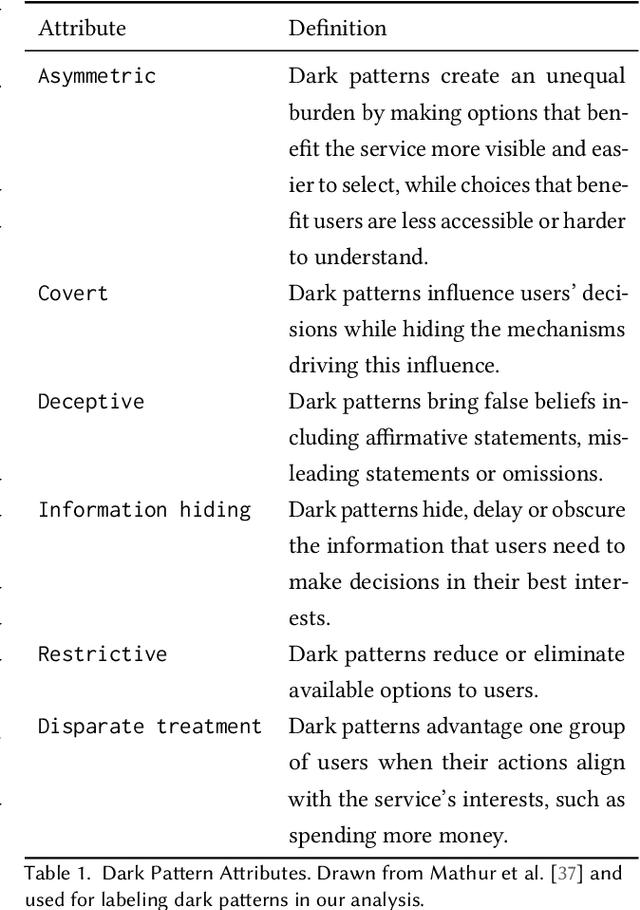
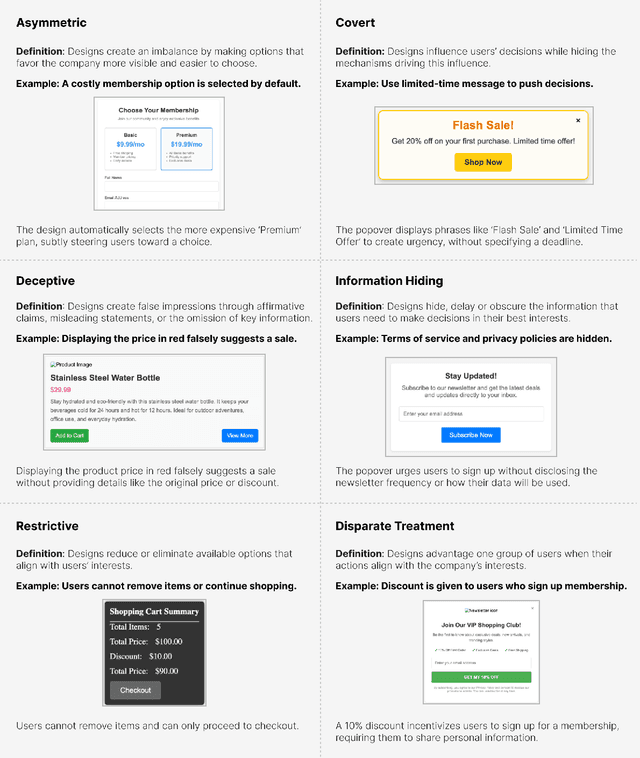
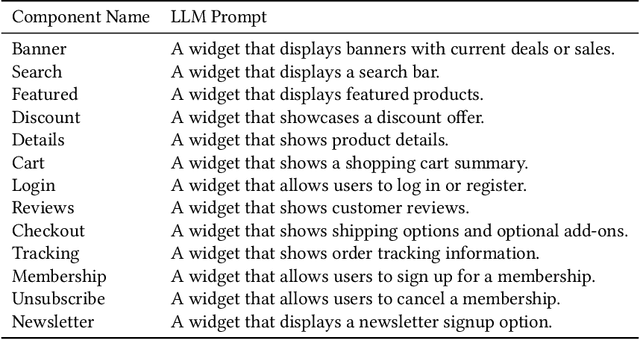
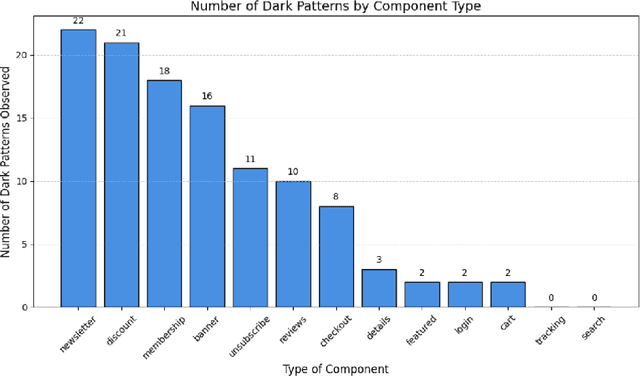
Abstract:Recent work has highlighted the risks of LLM-generated content for a wide range of harmful behaviors, including incorrect and harmful code. In this work, we extend this by studying whether LLM-generated web design contains dark patterns. This work evaluated designs of ecommerce web components generated by four popular LLMs: Claude, GPT, Gemini, and Llama. We tested 13 commonly used ecommerce components (e.g., search, product reviews) and used them as prompts to generate a total of 312 components across all models. Over one-third of generated components contain at least one dark pattern. The majority of dark pattern strategies involve hiding crucial information, limiting users' actions, and manipulating them into making decisions through a sense of urgency. Dark patterns are also more frequently produced in components that are related to company interests. These findings highlight the need for interventions to prevent dark patterns during front-end code generation with LLMs and emphasize the importance of expanding ethical design education to a broader audience.
InfiniteWorld: A Unified Scalable Simulation Framework for General Visual-Language Robot Interaction
Dec 08, 2024Abstract:Realizing scaling laws in embodied AI has become a focus. However, previous work has been scattered across diverse simulation platforms, with assets and models lacking unified interfaces, which has led to inefficiencies in research. To address this, we introduce InfiniteWorld, a unified and scalable simulator for general vision-language robot interaction built on Nvidia Isaac Sim. InfiniteWorld encompasses a comprehensive set of physics asset construction methods and generalized free robot interaction benchmarks. Specifically, we first built a unified and scalable simulation framework for embodied learning that integrates a series of improvements in generation-driven 3D asset construction, Real2Sim, automated annotation framework, and unified 3D asset processing. This framework provides a unified and scalable platform for robot interaction and learning. In addition, to simulate realistic robot interaction, we build four new general benchmarks, including scene graph collaborative exploration and open-world social mobile manipulation. The former is often overlooked as an important task for robots to explore the environment and build scene knowledge, while the latter simulates robot interaction tasks with different levels of knowledge agents based on the former. They can more comprehensively evaluate the embodied agent's capabilities in environmental understanding, task planning and execution, and intelligent interaction. We hope that this work can provide the community with a systematic asset interface, alleviate the dilemma of the lack of high-quality assets, and provide a more comprehensive evaluation of robot interactions.
Balance of Number of Embedding and their Dimensions in Vector Quantization
Jul 06, 2024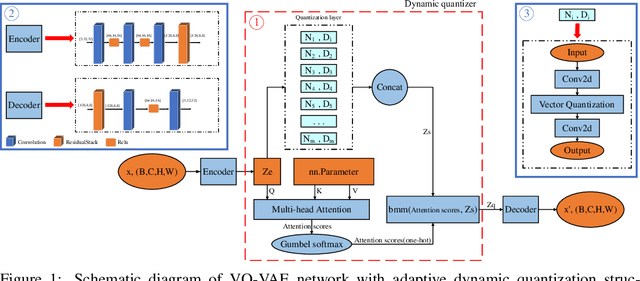
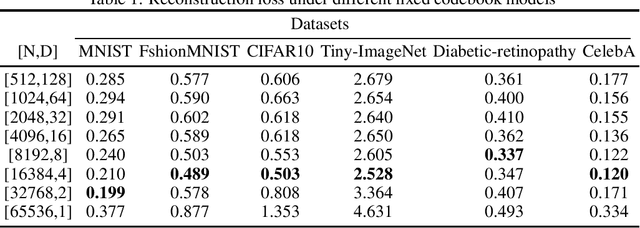
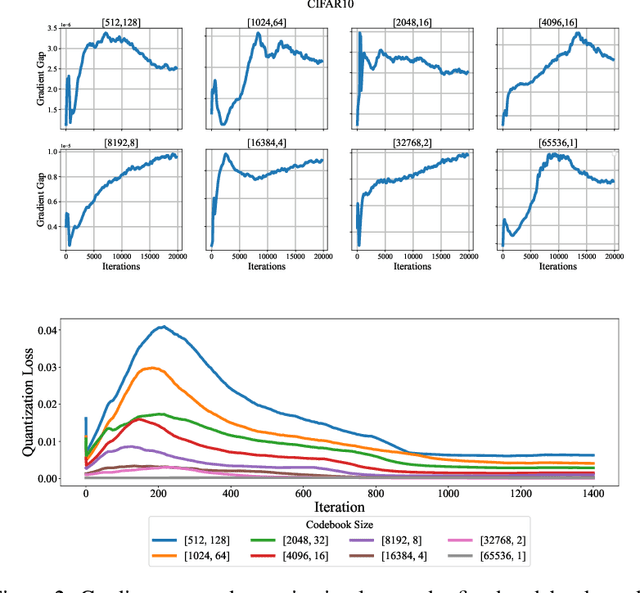

Abstract:The dimensionality of the embedding and the number of available embeddings ( also called codebook size) are critical factors influencing the performance of Vector Quantization(VQ), a discretization process used in many models such as the Vector Quantized Variational Autoencoder (VQ-VAE) architecture. This study examines the balance between the codebook sizes and dimensions of embeddings in VQ, while maintaining their product constant. Traditionally, these hyper parameters are static during training; however, our findings indicate that augmenting the codebook size while simultaneously reducing the embedding dimension can significantly boost the effectiveness of the VQ-VAE. As a result, the strategic selection of codebook size and embedding dimensions, while preserving the capacity of the discrete codebook space, is critically important. To address this, we propose a novel adaptive dynamic quantization approach, underpinned by the Gumbel-Softmax mechanism, which allows the model to autonomously determine the optimal codebook configuration for each data instance. This dynamic discretizer gives the VQ-VAE remarkable flexibility. Thorough empirical evaluations across multiple benchmark datasets validate the notable performance enhancements achieved by our approach, highlighting the significant potential of adaptive dynamic quantization to improve model performance.
Discrete Messages Improve Communication Efficiency among Isolated Intelligent Agents
Dec 28, 2023



Abstract:Individuals, despite having varied life experiences and learning processes, can communicate effectively through languages. This study aims to explore the efficiency of language as a communication medium. We put forth two specific hypotheses: First, discrete messages are more effective than continuous ones when agents have diverse personal experiences. Second, communications using multiple discrete tokens are more advantageous than those using a single token. To valdate these hypotheses, we designed multi-agent machine learning experiments to assess communication efficiency using various information transmission methods between speakers and listeners. Our empirical findings indicate that, in scenarios where agents are exposed to different data, communicating through sentences composed of discrete tokens offers the best inter-agent communication efficiency. The limitations of our finding include lack of systematic advantages over other more sophisticated encoder-decoder model such as variational autoencoder and lack of evluation on non-image dataset, which we will leave for future studies.
Are We Ready for Vision-Centric Driving Streaming Perception? The ASAP Benchmark
Dec 17, 2022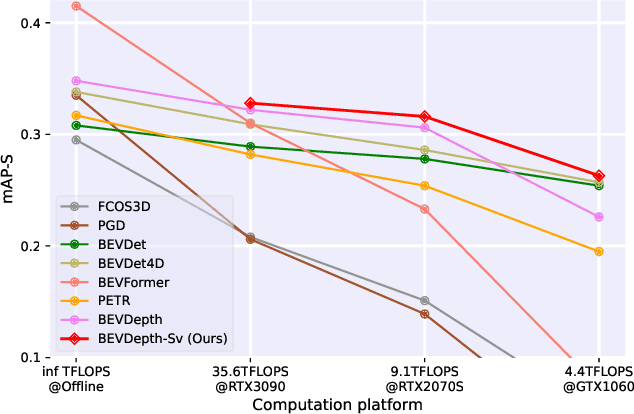

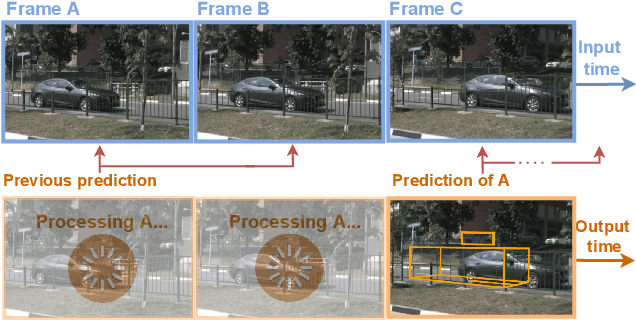
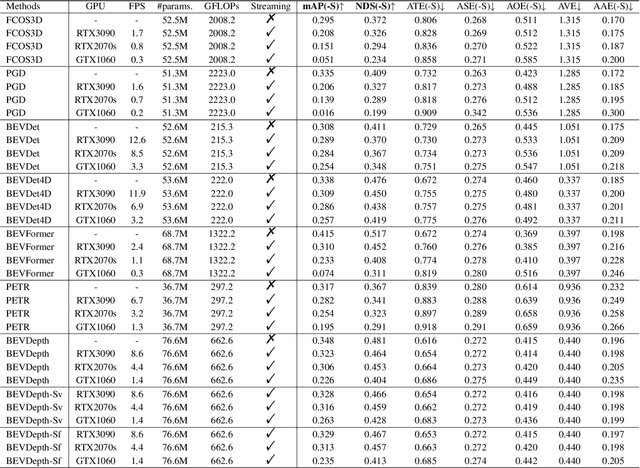
Abstract:In recent years, vision-centric perception has flourished in various autonomous driving tasks, including 3D detection, semantic map construction, motion forecasting, and depth estimation. Nevertheless, the latency of vision-centric approaches is too high for practical deployment (e.g., most camera-based 3D detectors have a runtime greater than 300ms). To bridge the gap between ideal research and real-world applications, it is necessary to quantify the trade-off between performance and efficiency. Traditionally, autonomous-driving perception benchmarks perform the offline evaluation, neglecting the inference time delay. To mitigate the problem, we propose the Autonomous-driving StreAming Perception (ASAP) benchmark, which is the first benchmark to evaluate the online performance of vision-centric perception in autonomous driving. On the basis of the 2Hz annotated nuScenes dataset, we first propose an annotation-extending pipeline to generate high-frame-rate labels for the 12Hz raw images. Referring to the practical deployment, the Streaming Perception Under constRained-computation (SPUR) evaluation protocol is further constructed, where the 12Hz inputs are utilized for streaming evaluation under the constraints of different computational resources. In the ASAP benchmark, comprehensive experiment results reveal that the model rank alters under different constraints, suggesting that the model latency and computation budget should be considered as design choices to optimize the practical deployment. To facilitate further research, we establish baselines for camera-based streaming 3D detection, which consistently enhance the streaming performance across various hardware. ASAP project page: https://github.com/JeffWang987/ASAP.
Crafting Monocular Cues and Velocity Guidance for Self-Supervised Multi-Frame Depth Learning
Aug 19, 2022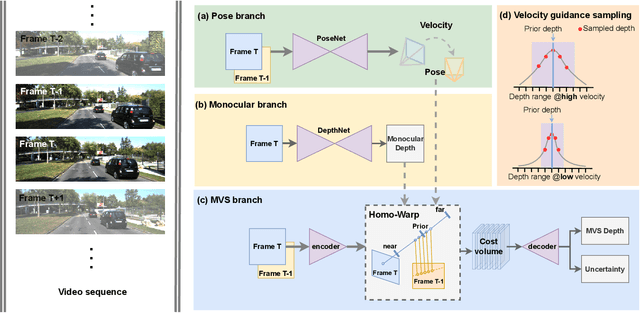
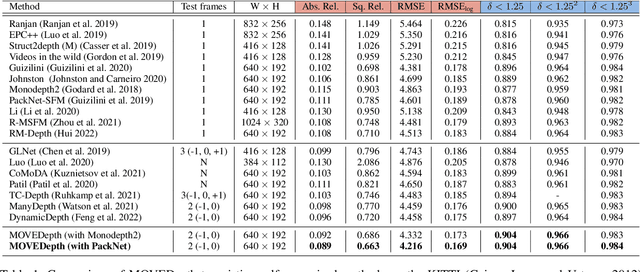
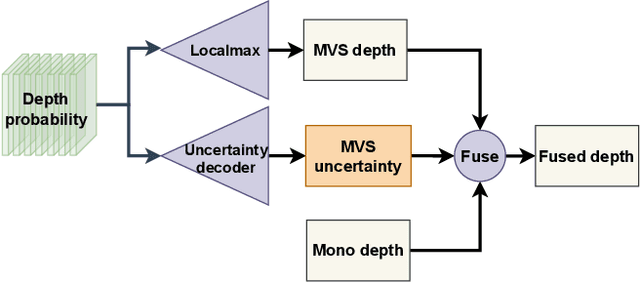

Abstract:Self-supervised monocular methods can efficiently learn depth information of weakly textured surfaces or reflective objects. However, the depth accuracy is limited due to the inherent ambiguity in monocular geometric modeling. In contrast, multi-frame depth estimation methods improve the depth accuracy thanks to the success of Multi-View Stereo (MVS), which directly makes use of geometric constraints. Unfortunately, MVS often suffers from texture-less regions, non-Lambertian surfaces, and moving objects, especially in real-world video sequences without known camera motion and depth supervision. Therefore, we propose MOVEDepth, which exploits the MOnocular cues and VElocity guidance to improve multi-frame Depth learning. Unlike existing methods that enforce consistency between MVS depth and monocular depth, MOVEDepth boosts multi-frame depth learning by directly addressing the inherent problems of MVS. The key of our approach is to utilize monocular depth as a geometric priority to construct MVS cost volume, and adjust depth candidates of cost volume under the guidance of predicted camera velocity. We further fuse monocular depth and MVS depth by learning uncertainty in the cost volume, which results in a robust depth estimation against ambiguity in multi-view geometry. Extensive experiments show MOVEDepth achieves state-of-the-art performance: Compared with Monodepth2 and PackNet, our method relatively improves the depth accuracy by 20\% and 19.8\% on the KITTI benchmark. MOVEDepth also generalizes to the more challenging DDAD benchmark, relatively outperforming ManyDepth by 7.2\%. The code is available at https://github.com/JeffWang987/MOVEDepth.
PMFL: Partial Meta-Federated Learning for heterogeneous tasks and its applications on real-world medical records
Dec 10, 2021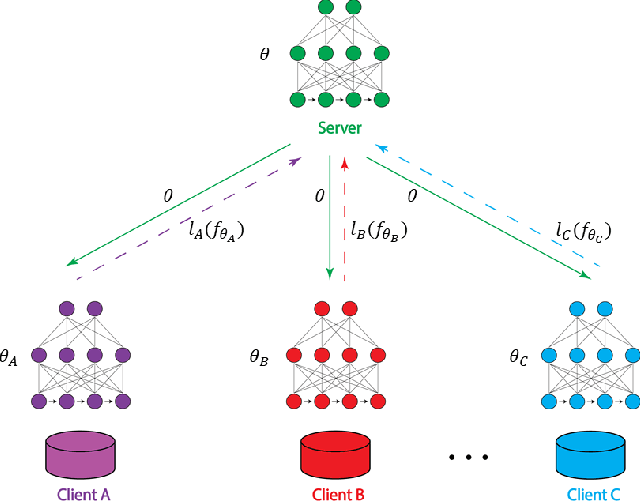



Abstract:Federated machine learning is a versatile and flexible tool to utilize distributed data from different sources, especially when communication technology develops rapidly and an unprecedented amount of data could be collected on mobile devices nowadays. Federated learning method exploits not only the data but the computational power of all devices in the network to achieve more efficient model training. Nevertheless, while most traditional federated learning methods work well for homogeneous data and tasks, adapting the method to a different heterogeneous data and task distribution is challenging. This limitation has constrained the applications of federated learning in real-world contexts, especially in healthcare settings. Inspired by the fundamental idea of meta-learning, in this study we propose a new algorithm, which is an integration of federated learning and meta-learning, to tackle this issue. In addition, owing to the advantage of transfer learning for model generalization, we further improve our algorithm by introducing partial parameter sharing. We name this method partial meta-federated learning (PMFL). Finally, we apply the algorithms to two medical datasets. We show that our algorithm could obtain the fastest training speed and achieve the best performance when dealing with heterogeneous medical datasets.
A trained humanoid robot can perform human-like crossmodal social attention conflict resolution
Nov 02, 2021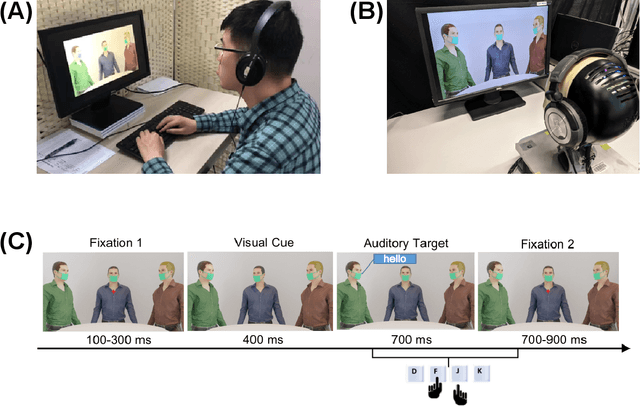
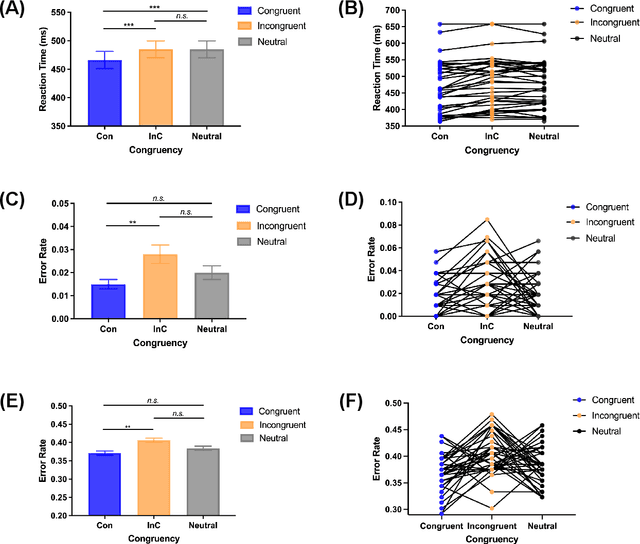
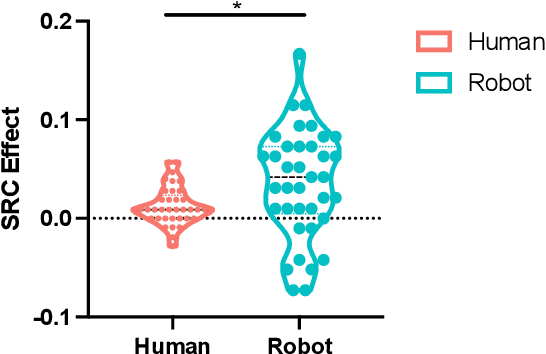
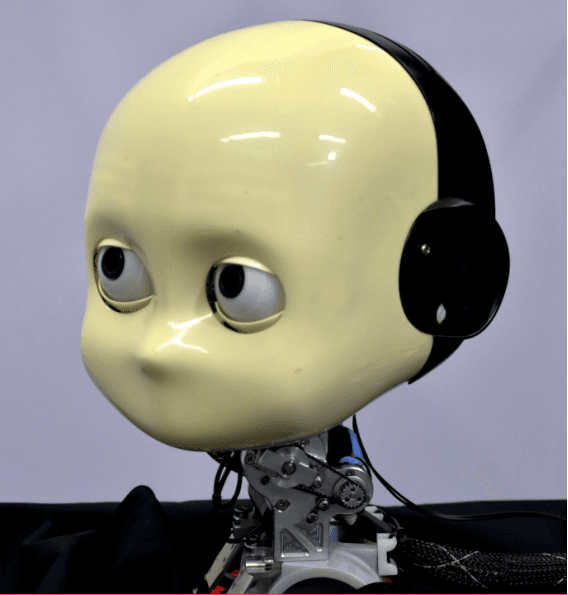
Abstract:Due to the COVID-19 pandemic, robots could be seen as potential resources in tasks like helping people work remotely, sustaining social distancing, and improving mental or physical health. To enhance human-robot interaction, it is essential for robots to become more socialised, via processing multiple social cues in a complex real-world environment. Our study adopted a neurorobotic paradigm of gaze-triggered audio-visual crossmodal integration to make an iCub robot express human-like social attention responses. At first, a behavioural experiment was conducted on 37 human participants. To improve ecological validity, a round-table meeting scenario with three masked animated avatars was designed with the middle one capable of performing gaze shift, and the other two capable of generating sound. The gaze direction and the sound location are either congruent or incongruent. Masks were used to cover all facial visual cues other than the avatars' eyes. We observed that the avatar's gaze could trigger crossmodal social attention with better human performance in the audio-visual congruent condition than in the incongruent condition. Then, our computational model, GASP, was trained to implement social cue detection, audio-visual saliency prediction, and selective attention. After finishing the model training, the iCub robot was exposed to similar laboratory conditions as human participants, demonstrating that it can replicate similar attention responses as humans regarding the congruency and incongruency performance, while overall the human performance was still superior. Therefore, this interdisciplinary work provides new insights on mechanisms of crossmodal social attention and how it can be modelled in robots in a complex environment.
Video Based Fall Detection Using Human Poses
Jul 29, 2021
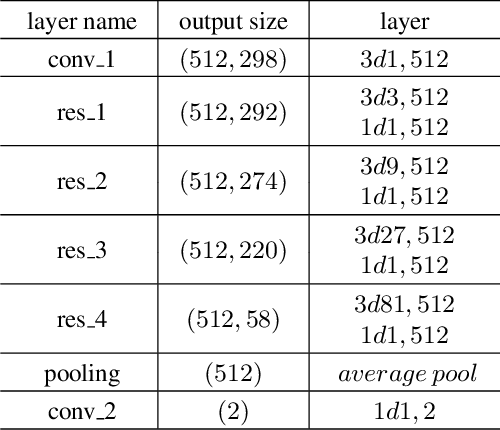


Abstract:Video based fall detection accuracy has been largely improved due to the recent progress on deep convolutional neural networks. However, there still exists some challenges, such as lighting variation, complex background, which degrade the accuracy and generalization ability of these approaches. Meanwhile, large computation cost limits the application of existing fall detection approaches. To alleviate these problems, a video based fall detection approach using human poses is proposed in this paper. First, a lightweight pose estimator extracts 2D poses from video sequences and then 2D poses are lifted to 3D poses. Second, we introduce a robust fall detection network to recognize fall events using estimated 3D poses, which increases respective filed and maintains low computation cost by dilated convolutions. The experimental results show that the proposed fall detection approach achieves a high accuracy of 99.83% on large benchmark action recognition dataset NTU RGB+D and real-time performance of 18 FPS on a non-GPU platform and 63 FPS on a GPU platform.
 Add to Chrome
Add to Chrome Add to Firefox
Add to Firefox Add to Edge
Add to Edge